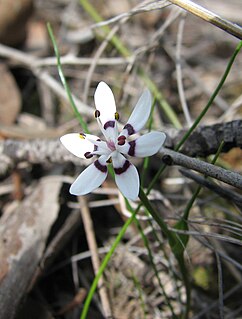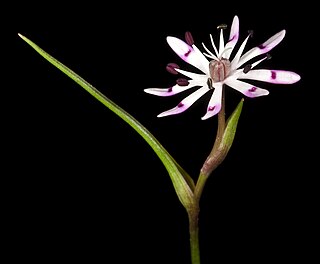
Wurmbea is a genus of perennial herbs in the family Colchicaceae, native to Africa and Australia. There are about 50 species, with about half endemic to each continent.

Wurmbea dioica, commonly known as early Nancy, is a species of plant in the family Colchicaceae and is endemic to Australia. It is a herb with three linear to thread-like leaves and usually two to seven white flowers with a purple or greenish nectary band.
Terry Desmond Macfarlane is a botanist and taxonomist, who has worked in both Australia and Peru. A senior research scientist at the Western Australian Herbarium, Macfarlane is associate editor of its journal Nuytsia and currently collaborates with researchers across Australia and in Canada, Germany, New Zealand, Russia, Spain and United Kingdom. He was also involved in the development of FloraBase, the Western Australian flora database.

Wurmbea tenella, common name - eight nancy, is a perennial herb in the Colchicaceae family that is native to Western Australia.
Wurmbea tubulosa, also known as Long-flowered Nancy, is a species of plant in the Colchicaceae family that is endemic to Australia. It is classified as Endangered under Australia's EPBC Act.
Wurmbea calcicola, also known as Naturaliste Nancy, is a species of plant in the Colchicaceae family that is endemic to Australia. It is classified as Endangered under Australia's EPBC Act.
Wurmbea graniticola is a species of plant in the Colchicaceae family that is endemic to Australia.
Wurmbea inframediana is a species of plant in the Colchicaceae family that is endemic to Australia.
Wurmbea dilatata is a species of plant in the Colchicaceae family that is endemic to Australia.
Wurmbea cernua is a species of plant in the Colchicaceae family that is endemic to Australia.
Wurmbea latifolia, also known as Broadleaf Early Nancy, is a species of plant in the Colchicaceae family that is endemic to Australia.
Wurmbea deserticola is a species of plant in the Colchicaceae family that is endemic to Australia.
Wurmbea inflata is a species of plant in the Colchicaceae family that is endemic to Australia. The specific epithet inflata (‘bladdery’) refers to the enlarged fruits.
Wurmbea fluviatilis is a species of plant in the Colchicaceae family that is endemic to Australia. The specific epithet fluviatilis (‘riverine’) refers to the species' riverside habitat.
Wurmbea saccata is a species of plant in the Colchicaceae family that is endemic to Australia.
Wurmbea densiflora is a species of plant in the Colchicaceae family that is endemic to Australia.
Wurmbea drummondii, also known as the York Gum Nancy, is a species of plant in the Colchicaceae family that is endemic to Australia.
Wurmbea pygmaea is a species of plant in the Colchicaceae family that is endemic to Australia.
Wurmbea pygmaea, also known as One-flower Nancy, is a species of plant in the Colchicaceae family that is endemic to Australia.

Wurmbea biglandulosa is a species of plant in the Colchicaceae family that is endemic to Australia.



